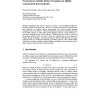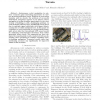135 search results - page 8 / 27 » ANFIS Approach for Navigation of Mobile Robots |
102
Voted
ICRA
2000
IEEE
15 years 4 months ago
2000
IEEE
Potential function approaches to robot navigation provide an elegant paradigm for expressing multiple constraints and goals in mobile robot navigation problems 9]. As an example, ...
103
click to vote
FSR
2007
Springer
15 years 6 months ago
2007
Springer
Sampling in the space of controls or actions is a well-established method for ensuring feasible local motion plans. However, as mobile robots advance in performance and competence ...
ICRA
2010
IEEE
14 years 10 months ago
2010
IEEE
Abstract— Autonomous robot navigation in outdoor scenarios gains increasing importance in various growing application areas. Whereas in non-urban domains such as deserts the prob...
96
Voted
ICRA
2007
IEEE
15 years 6 months ago
2007
IEEE
— This paper describes a probabilistic framework for navigation using only appearance data. By learning a generative model of appearance, we can compute not only the similarity o...
96
Voted
ICML
1996
IEEE
16 years 1 months ago
1996
IEEE
Autonomous mobile robots need good models of their environment, sensors and actuators to navigate reliably and efficiently. While this information can be supplied by humans, or le...


